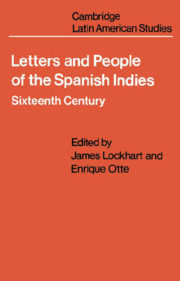Book contents
- Frontmatter
- Contents
- Preface
- Part I Conquest
- Part II The Variety of Life in the Indies
- Part III officials and Clerics
- 29 How a governor operates
- 30 Alarm and drastic remedies: A viceroy's view of New Spain
- 31 The concerns of a judge
- 32 bishop and the governor
- 33 A bishop's affairs
- 34 Franciscans and the Indians
- 35 The Dominican attack
- 36 The Franciscan reply
- 37 The petty administrator
- 38 The parish priest
- Bibliography
- Index
34 - Franciscans and the Indians
from Part III - officials and Clerics
Published online by Cambridge University Press: 06 August 2018
- Frontmatter
- Contents
- Preface
- Part I Conquest
- Part II The Variety of Life in the Indies
- Part III officials and Clerics
- 29 How a governor operates
- 30 Alarm and drastic remedies: A viceroy's view of New Spain
- 31 The concerns of a judge
- 32 bishop and the governor
- 33 A bishop's affairs
- 34 Franciscans and the Indians
- 35 The Dominican attack
- 36 The Franciscan reply
- 37 The petty administrator
- 38 The parish priest
- Bibliography
- Index
Summary
Fray Pedro de Gante, in Mexico City, to the emperor, 1532
… There are very good scribes and preachers or speakers of great fervor, and singers who could sing in your majesty's chapel choir …
Either secular priests or friars could man the ecclesiastical component of the encomienda, taking the chief encomienda town as a headquarters and from there instructing the Indians of the region in Christianity. In the Mexico of the first generation, friars of the mendicant orders were most associated with this function, and of these the Franciscans were preeminent. Arriving in the country ftrst, they evolved methods which the other orders followed by and large, building great monastery churches and cloisters which became the primary public places of the Indian towns and even, since they often contained three or four friars and served a corresponding number of encomienda districts, tended to free the order from too great a local dependence on any individual encomendero. The rural monasteries were satellites of the even larger ones in the cities, above all Mexico City.
In the larger centers there took place the most famous episode in early Spanish American cultural history: a concerted Franciscan effort ftrst to learn Nahuatl, and then using this tool to teach a selected number of Indians the refmements of European culture, including writing, grammatical and rhetorical principles, all the arts and crafts, sometimes even Latin. It is quite hard to get a proper perspective on the success of the program. The achievements are formidable. The monasteries, if they as works of art are considered part of the effort, dominate the Mexican countryside to this day. Literacy in Nahuatl was another result with lasting signiftcance; the first generation of notaries whom the friars taught taught others in turn, so that a selfsustaining Nahuatl literacy and record-keeping continued to flourish in the Indian towns until the end of the colonial period.
But if such were the results, one must wonder if the welldeveloped Mesoamerican traditions of glyphic-pictorial writing and prolific monumental building were not the most important causative factors. In discussing the general progress of acculturation in central Mexico, one must remember how few people in how few places were involved in such programs, and that the effort slacked off to almost nothing in a generation or two.
- Type
- Chapter
- Information
- Letters and People of the Spanish IndiesSixteenth Century, pp. 211 - 214Publisher: Cambridge University PressPrint publication year: 1976



